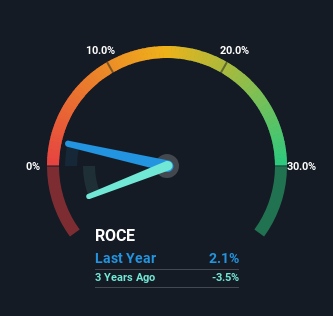- India
- /
- Paper and Forestry Products
- /
- NSEI:ORIENTPPR
Be Wary Of Orient Paper & Industries (NSE:ORIENTPPR) And Its Returns On Capital

Finding a business that has the potential to grow substantially is not easy, but it is possible if we look at a few key financial metrics. One common approach is to try and find a company with returns on capital employed (ROCE) that are increasing, in conjunction with a growing amount of capital employed. Basically this means that a company has profitable initiatives that it can continue to reinvest in, which is a trait of a compounding machine. However, after investigating Orient Paper & Industries (NSE:ORIENTPPR), we don't think it's current trends fit the mold of a multi-bagger.
Return On Capital Employed (ROCE): What Is It?
For those who don't know, ROCE is a measure of a company's yearly pre-tax profit (its return), relative to the capital employed in the business. Analysts use this formula to calculate it for Orient Paper & Industries:
Return on Capital Employed = Earnings Before Interest and Tax (EBIT) ÷ (Total Assets - Current Liabilities)
0.021 = ₹426m ÷ (₹24b - ₹4.1b) (Based on the trailing twelve months to March 2024).
Therefore, Orient Paper & Industries has an ROCE of 2.1%. In absolute terms, that's a low return and it also under-performs the Forestry industry average of 12%.
See our latest analysis for Orient Paper & Industries

While the past is not representative of the future, it can be helpful to know how a company has performed historically, which is why we have this chart above. If you're interested in investigating Orient Paper & Industries' past further, check out this free graph covering Orient Paper & Industries' past earnings, revenue and cash flow.
What The Trend Of ROCE Can Tell Us
On the surface, the trend of ROCE at Orient Paper & Industries doesn't inspire confidence. Around five years ago the returns on capital were 6.7%, but since then they've fallen to 2.1%. However it looks like Orient Paper & Industries might be reinvesting for long term growth because while capital employed has increased, the company's sales haven't changed much in the last 12 months. It may take some time before the company starts to see any change in earnings from these investments.
The Bottom Line
In summary, Orient Paper & Industries is reinvesting funds back into the business for growth but unfortunately it looks like sales haven't increased much just yet. Although the market must be expecting these trends to improve because the stock has gained 64% over the last five years. Ultimately, if the underlying trends persist, we wouldn't hold our breath on it being a multi-bagger going forward.
Like most companies, Orient Paper & Industries does come with some risks, and we've found 2 warning signs that you should be aware of.
While Orient Paper & Industries may not currently earn the highest returns, we've compiled a list of companies that currently earn more than 25% return on equity. Check out this free list here.
New: AI Stock Screener & Alerts
Our new AI Stock Screener scans the market every day to uncover opportunities.
• Dividend Powerhouses (3%+ Yield)
• Undervalued Small Caps with Insider Buying
• High growth Tech and AI Companies
Or build your own from over 50 metrics.
Have feedback on this article? Concerned about the content? Get in touch with us directly. Alternatively, email editorial-team (at) simplywallst.com.
This article by Simply Wall St is general in nature. We provide commentary based on historical data and analyst forecasts only using an unbiased methodology and our articles are not intended to be financial advice. It does not constitute a recommendation to buy or sell any stock, and does not take account of your objectives, or your financial situation. We aim to bring you long-term focused analysis driven by fundamental data. Note that our analysis may not factor in the latest price-sensitive company announcements or qualitative material. Simply Wall St has no position in any stocks mentioned.
About NSEI:ORIENTPPR
Orient Paper & Industries
Manufactures and sells paper and other products in India.
Second-rate dividend payer with imperfect balance sheet.
Similar Companies
Market Insights
Community Narratives




